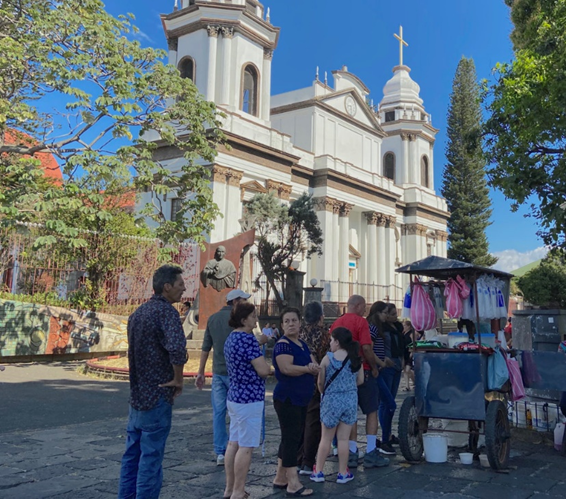Alajuela is the second largest province in
Costa Rica and is located some 12 miles northeast of the capital along the
General Cañas highway.
The city of Alajuela is also known as the
“City of Mangos” because of its large number of mango trees, especially around
Central Park.
As of 2011, the province had a population
of 885,571. Its diversity of production is the driving force behind the local
and national economy.
The area around the Juan Santamaria
International Airport, the main entry point to Costa Rica, is developing into a
large district of exporting businesses. Many of these businesses are
manufacturing industries that work within the free trade zones.
Visitors will find many attractions to see,
including the Juan Santamaria History Museum, the Alajuela Cultural Center and
the Cathedral that was restored in 2010, whose interior displays dramatic works
of art.
Its warm climate and friendly people, as
well as many interesting points of interest that can be reached on foot makes
the county of Alajuela a place definitely worth seeing.
Alajuela, city,
northwestern Costa Rica. It lies in the Valle Central
at an elevation of 3,141 feet (957 metres).
Known in colonial days as Villahermosa, the
town was active in support of independence from Spain in 1821; five years later
it suffered from a plot to restore Spanish control over Costa Rica. For a brief
period in the 1830s Alajuela served as the nation’s capital. It was the home of
Juan Santamaría, a Costa Rican soldier and hero of the defense against the
invasion by the American filibuster (military adventurer) William Walker in
1856. The local Cultural Historical Museum is named in Santamaría’s honour, as
is the country’s principal airport, which is located 2 miles (3 km) from
Alajuela city.
A slightly lower elevation and a warmer climate, as compared with San José 12.5 miles (20 km) to the southeast, give Alajuela the air of a resort. Called the City of Mangoes, it is also known for its flowers and markets.
 |
| https://upload.wikimedia.org/wikipedia/commons/thumb/9/97/Territorio_tradicional_guatuso.png/440px-Territorio_tradicional_guatuso.png |
Founding
Alajuela
Because land holdings in Cartago, the
colonial capital of the region, were already controlled by large encomiendas,
many settlers began moving west beginning in the mid-1600s. In 1657, Alajuela
was mentioned for the first time in the writings of Juana de Vera y Sotomayor,
a traveler who described an encomienda "on La Lajuela river." Before
taking on the name of Alajuela, the area was known as Villahermosa.
Esteban Lorenzo de Tristán, Bishop of Nicaragua, Nicoya, and Costa Rica, tried organizing Catholic communities west of Heredia. In doing so, he inaugurated a small oratory to unite the scattered settlers. The oratory was centered in the village of "La Lajuela," between the Ciruelas and Alajuela rivers. Because of its creation, the city of Alajuela was officially founded on 12 October 1782. In 1790, the first official parish of Alajuela was established, led by the priest Manuel López del Corral. The creation of a parish brought more settlers to the region. Soon, they began moving further and further toward the edges of the Central Valley, founding Atenas in 1836, San Ramón in 1854, and Grecia in 1856. Soon, the cities of Naranjo, Zarcero, and Quesada were founded as well.
National
independence
In 1823, during the First Costa Rican Civil
War, Costa Rica was divided into two groups: The Imperialists, who were loyal
to the First Mexican Empire, and the Republicans, who wanted independence. For
the most part, Alajuela and San José fought against the coup staged by the
Republicans in Heredia and Cartago. The Alajuelan side won, and Costa Rica left
the Mexican Empire shortly before it dissolved. While Costa Rica was a member
of the Federal Republic of Central America in the 1830s, the city of Alajuela
was the nation's capital.[8]
In 1831, Alajuelan folk hero Juan
Santamaría was born. Santamaría was a peasant boy who volunteered as a drummer
during the Campaign of 1856-1857. On 11 April 1856, Santamaría sacrificed
himself to burn filibuster William Walker's stronghold at Santa Rosa, asking
only that his mother be taken care of.
Settlement of the northern portion of
Alajuela only began in earnest in the later half of the 19th century, and even
so did not reach great proportions until the second half of the 20th century,
owing largely to the difficult access. Much of the original colonization came
from Nicaragua since numerous navigable rivers flow north from their origins in
the cordilleras and empty into either Lake Nicaragua or the San Juan River. By
1850, the province had a population of approximately 15,540.
A seminal event in Alajuela's history was
the 1968 eruption of Volcán Arenal. Residents previously referred to it as
Mount Arenal. In the years before the eruption, residents reported rises in the
temperature of ground water and small tremors. Beginning on 28 July 1969,
residents of surrounding towns reported constant tremors. The eruptions began
on 29 July, spewing ash into the neighboring provinces and launching boulders
into the sky. The initial explosions were so strong that three craters were
instantaneously created. The cities of Tabacón, Pueblo Nuevo and San Luís were
buried, killing 87 people. Crops were destroyed and livestock were killed.
 |
| https://www.google.com/url?sa=i&url=https%3A%2F%2Fthereaderwiki.com%2Fes%2FAlajuela&psig=AOvVaw0pxNLNxUvdKdfPfdGTVk4V&ust=1667678881014000&source=images&cd=vfe&vdAAAAABAJ |
















